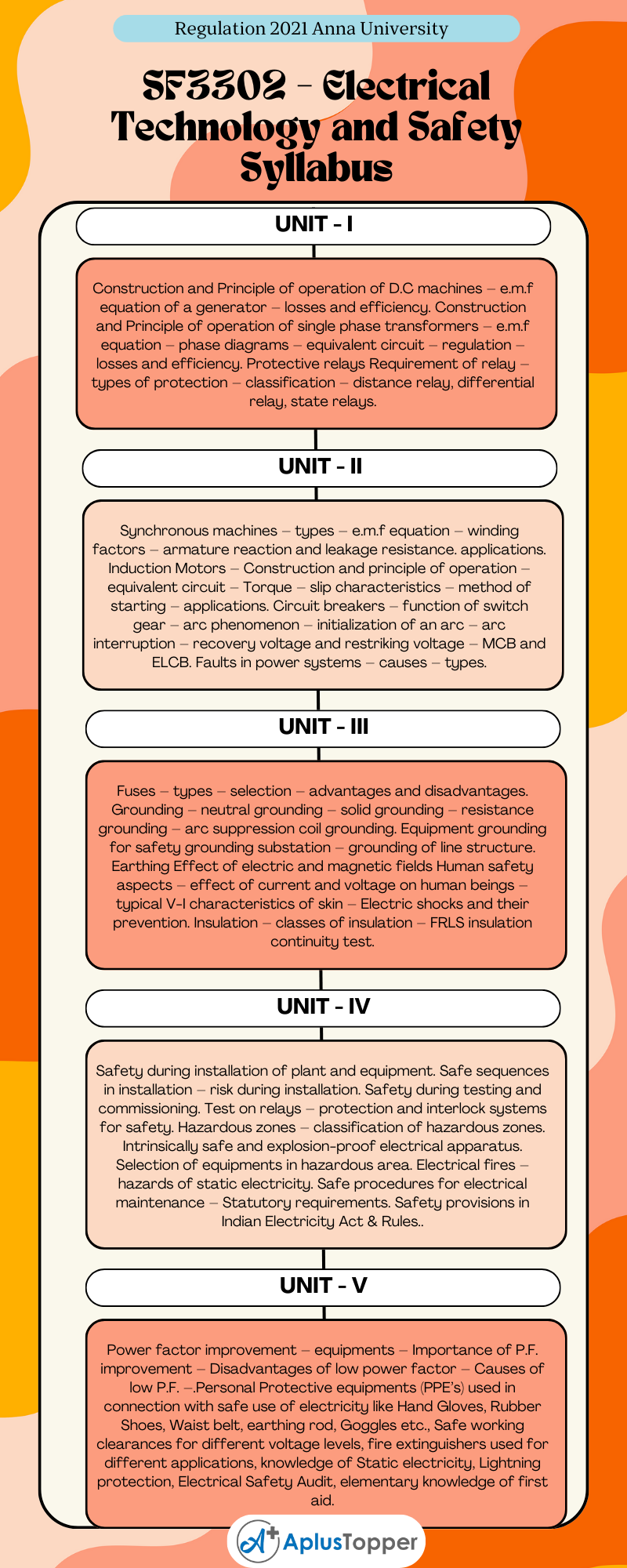In this article, we tried our best to provide the syllabus regarding Anna University awarding the B.E Safety and Fire Engineering syllabus Semester III subject Electrical Technology and Safety.
We include more details along with the syllabus of SF3302 – Electrical Technology and Safety, by the expertise ones with required textbooks and references for additional purposes to make your preparation easy. You just simply follow the unit-wise syllabus to excel in academics. Hope this information is useful. Comment below if you have any doubts relevant to the subject in the given below comment box. Kindly share it with your friends.
If you want to know more about the B.E Safety And Fire Engineering syllabus connected to an affiliated institution’s four-year undergraduate degree program. We provide you with a detailed Year-wise, semester-wise, and Subject-wise syllabus in the following link B.E Safety And Fire Engineering Syllabus Regulation 2021 Anna University.
Aim Of Objectives:
- Understand the basic principles of operation of rotating electric machines (Generators and Motors), their classification and basic efficiency and performance characteristics.
- Brief the legislative requirements for electrical safety – national/international laws/codes of practices/ standards and/or regulations.
- Use a “Status Check” survey to assess the facility’s electrical safety program and where necessary develop strategies for improvement.
- Identify persons who may be exposed to a source of electrical energy directly or indirectly.
- Describe the essential parts of a Flash Hazard Analysis and list the data required analysis.
SF3302 – Electrical Technology and Safety Syllabus
Unit – I: Elementary Ideas Of DC Machines, Transformers And Relays
Construction and Principle of operation of D.C machines – e.m.f equation of a generator – losses and efficiency. Construction and Principle of operation of single phase transformers – e.m.f equation – phase diagrams – equivalent circuit – regulation – losses and efficiency. Protective relays Requirement of relay – types of protection – classification – distance relay, differential relay, state relays.
Unit – II: Synchronous, Induction Motor, And Their Electrical Circuit Breakers
Synchronous machines – types – e.m.f equation – winding factors – armature reaction and leakage resistance. applications. Induction Motors – Construction and principle of operation – equivalent circuit – Torque – slip characteristics – method of starting – applications. Circuit breakers – function of switch gear – arc phenomenon – initialization of an arc – arc interruption – recovery voltage and restriking voltage – MCB and ELCB. Faults in power systems – causes – types.

Unit – III: Electrical Grounding, Earthling And Insulation
Fuses – types – selection – advantages and disadvantages. Grounding – neutral grounding – solid grounding – resistance grounding – arc suppression coil grounding. Equipment grounding for safety grounding substation – grounding of line structure. Earthing Effect of electric and magnetic fields Human safety aspects – effect of current and voltage on human beings – typical V-I characteristics of skin – Electric shocks and their prevention. Insulation – classes of insulation – FRLS insulation continuity test.
Unit – IV: Safety During Installation, Testing And Commissioning, Operation And Maintenance
Safety during installation of plant and equipment. Safe sequences in installation – risk during installation. Safety during testing and commissioning. Test on relays – protection and interlock systems for safety. Hazardous zones – classification of hazardous zones. Intrinsically safe and explosion-proof electrical apparatus. Selection of equipments in hazardous area. Electrical fires – hazards of static electricity. Safe procedures for electrical maintenance – Statutory requirements. Safety provisions in Indian Electricity Act & Rules..
Unit – V: Electricity And Fire Safety
power factor improvement – equipments – Importance of P.F. improvement – Disadvantages of low power factor – Causes of low P.F. –.Personal Protective equipments (PPE’s) used in connection with safe use of electricity like Hand Gloves, Rubber Shoes, Waist belt, earthing rod, Goggles etc., Safe working clearances for different voltage levels, fire extinguishers used for different applications, knowledge of Static electricity, Lightning protection, Electrical Safety Audit, elementary knowledge of first aid.
Text Books:
- Rao, S. and Saluja, H.L., “Electrical Safety, Fire Safety Engineering and Safety Management”, Khanna Publishers, 1988.
- Pradeep Chaturvedi, “Energy Management Policy, Planning and Utilization”, Concept Publishing Company, 1997.
References:
- Nagrath, I.J. and Kothari, D.P., “Power System Engineering”, Tata McGraw Hill, 1998.
- Wadhwa, C.L., “Electric Power Systems”, New Age International, 2004.
- J. Maxwell Adams. Electrical Safety A guide to the causes and prevention of electrical hazards, Published by The Institution of Engineering and Technology, London, United Kingdom, First published 1994 Reprinted 1997, 2004, 2009.
- Fordham-Cooper, W. (1998). Electrical safety engineering. Elsevier by Amsterdam.Bill Atkinson & Roger Lovegrove & Gary Gundry (auth.)Electrical Installation Designs, Fourth Edition @ 2013, John Wiley & Sons, Ltd.
- Kothari, D.P. and Nagrath, I.J. (2009). Basic electrical engineering. (Third edition). Tata McGraw Hill Publishing Company Ltd., New Delhi.
Related Posts On Semester – III:
- MA3351 – Transforms and Partial Differential Equations
- ME3351 – Engineering Mechanics
- CE3391 – Fluid Mechanics and Machinery
- SF3301 – Principles of Safety Management
Must Read:
